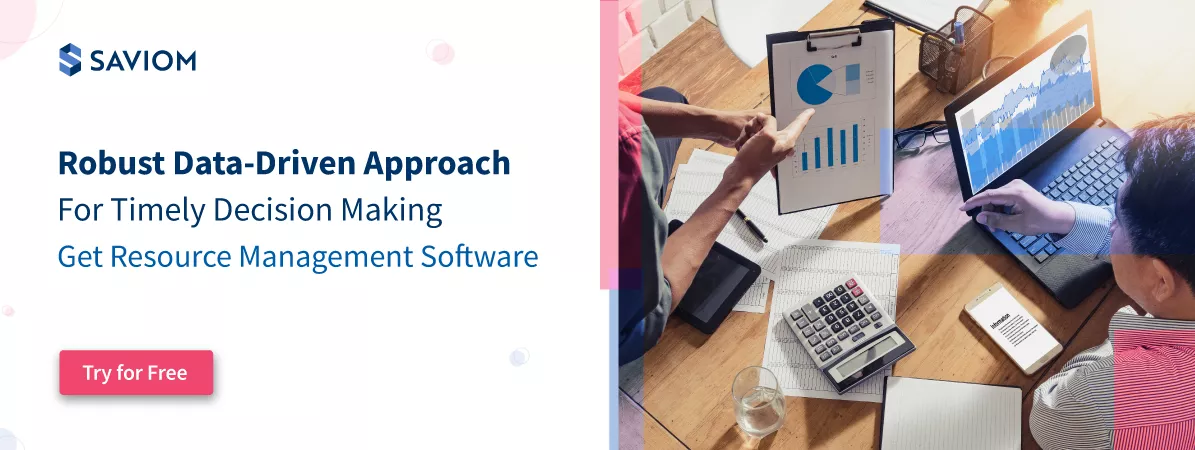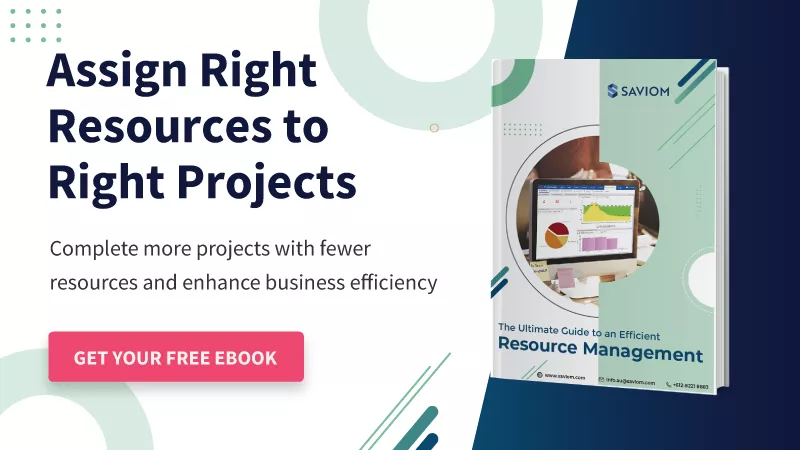What are the responsibilities of a resource manager?
The most common answers will range from resource planning, competent allocation to maintaining the resources’ billability. Sure, these are true. Resource managers around the world perform these similar functions. However, all these duties are easier said than done.
In today’s business landscape replete with complex matrix organizations, resource management goes beyond simple allocation. Resource managers need to factor in multiple attributes such as resource costs, location, experience, etc., before assigning a specific task.
Moreover, the onus lies on resource managers to analyze if the talent pool has the right skills or not, whether the resources are available for upcoming projects, and so on. Before forming a resource plan, they need to assess multiple resource metrics such as utilization, capacity, demand, etc.
Thus, they need to implement a data-driven approach that helps them gather, assess, and analyze information to form the best-fit resource plan. It will not only align with the project requirements but will also ascertain optimum utilization of the workforce.
This blog shall cover the importance of data-driven decision-making for resource managers and how a resource management software can help them achieve that.
Let’s start with the definition.
What is data-driven decision-making?
It is the process of using facts, metrics, and other complex details for making organizational decisions and forming an action plan rather than relying on intuition or observation alone. As per a survey conducted by PwC,
“Data-driven organizations are three times more likely to report significant decision-making improvements compared to those who rely less on data.”
In any business, data can be gathered from various sources. Some of which are:
- Collecting survey responses to gather feedback about products, services, and features used by customers.
- Undertaking user testing to observe customer inclination towards products or services and identify potential issues to resolve.
- Launching a new product or service in a test market to assess how it might perform in the market.
- Analyzing shifts in demographic data to determine business opportunities or threats.
All these ways can help organizations accumulate the necessary data for better decision-making. Below is an example of how Google used factual data to improve its managers’ performance.
In 2006, Google created the People Analytics Department to help the company decide if managers make a difference in their teams’ performance. It used performance reviews and employee surveys to find the facts. The data revealed that teams with better managers performed better and were more motivated at work. Besides, it also helped in understanding what makes a good manager. Using this data, Google established eight behaviors for good managers and used this data to measure managers against these behaviors.
Read More: 5 Top Project Metrics You Need to Use Today
In the following section, let’s discuss the importance of data-driven decision-making in project resource management.
Significance of data-driven decision-making in project resource management
Taking a data-driven approach enables resource managers to form an accurate resource plan and ensure competent allocation. Moreover, they can foresee pipeline project demand, utilization, etc., and leverage the data to create an adequate method of action ahead of time. Thus, implementing the data in the right manner can ensure timely delivery of projects and within budget.
In addition, data can take the guesswork and assumptions out of the decision-making process and provide tangible support to managers.
Here are some of the reasons why data-driven decision-making is vital in project resource management:
- First and foremost, documented data of previous projects can serve as a reference while planning similar future ones. For instance, project managers can view the previous resource estimations and form an improved plan avoiding mistakes.
- With data-backed reports, managers can identify which resources are being underutilized or overutilized. Moreover, they can understand if the forecasted schedules are followed or not. If there are deviations, then they can implement optimizing techniques accordingly and keep the project on track.
- Managers can use data analytics for better stakeholder engagement. They can present data-driven reports of necessary metrics in the form of graphs, dashboards, etc., for better comprehension.
- Implementing data analytics can also assist in identifying, ranking, and assessing resource-related risks in advance. That way, they can form a risk mitigation plan and avoid any potential bottlenecks.
- Lastly, with reports such as Capacity vs. Demand, managers can forecast if the existing resources will be matching the future project demand or not. If there are shortages or excess of resources, they can take necessary actions. Thus, it helps in resource capacity planning and building an optimized workforce.
Now that the importance of data-driven decision-making is evident, let’s understand how you can make data-driven decisions.
Steps involved in making data-driven decisions
Before you start analyzing your company’s data to formulate course corrective plans or to arrive at decisions, you must have every information on a single platform. And for that, one must have a roadmap to gather the data, analyze it, organize it, and make it comprehensible
Here is a detailed plan to find the data you need and interpret it to make the right business decisions:
Determine project goals and objectives
This is the first step in making decisions. You need to have a clear understanding of your project’s goals and objectives. These goals can be anything such as increasing efficiency, improving customer experience, reducing costs, etc.
Clarity over the goals will help you identify the KPIs needed for driving decisions. It will help you get an idea of which data you should target and analyze for the decision-making purpose.
Gather data from relevant sources- Data extraction
After you have identified your goals, you should gather data from the relevant departments in your organization. This process is also known as ‘extraction.’
Accumulating data from all the different sources also helps in data integration. These sources can be on-premise databases, CRM systems, marketing automation platforms, cloud data warehouses, unstructured and structured files, etc.
Read More: Which Cloud Computing Framework is Suitable for your Business?
Consolidate and analyze the data as needed- Data transformation
Once you have collected data from various sources, you need to consolidate and structure it on a single platform and make it comprehensible. This step is known as ‘transformation.’ Here, you have to compile, convert, format, and cleanse the data extracted for your audience.
Following this, you should analyze that data and conclude. Those conclusions must be understandable for everyone.
Form an action plan to take remedial measures
After you have extracted, compiled, and made the data presentable, it’s time for the decision-makers to go through the reports and develop actionable insights. With these insights, they can find the potential setbacks and form an action plan to combat them.
This is the phase where the data is transitioned into an actionable plan. Thus, managers need to form the best-fit plan that supports the organization’s profitability.
Monitor and improve the decision-making process
This is the final step in the whole process. Once the decisions are made from the data analysis and interpretation, you should assess them before taking a call. For instance, you should question yourself: Will the findings help in achieving the goals?
Once you have made the decisions and created an action plan, it’s time to execute and evaluate the results. If the results deviate from the expected values, then it implies you have to revisit the entire process and find out the loopholes.
Read More: What is Innovation Management, and Why is it Important?
In the next section, let’s understand how a resource management solution can boost your decision-making process.
How can resource management software help in making data-driven decisions?
Resource management software is a one-stop solution that procures multiple resource metrics reports in real-time and facilitates managers to utilize resources effectively. It helps in creating an optimized workforce and accomplishing the projects within time and budget.
Here is how a resource management software assists in the decision-making process:
Forms a unified resource and project repository
A resource management software maintains a single version of truth for enterprise-wide resources and projects. This centralized view of resources, their schedules, project bookings, and profiles allow managers to implement competent allocation, precise scheduling, and avoid double booking. Moreover, they can examine the various metrics, project statuses, resource skills, etc.
A unified repository helps everyone get 360-degree visibility of all the activities that are going on within the enterprise. Thus, concerned authorities can access the data and analyze the ongoing projects’ and resources’ health index on the unified platform. Moreover, the tool seamlessly integrates third-party software, minimizing data redundancy and allowing seamless interpretation of relevant insights.
Improves resource planning with “what if” analysis
What-if analysis is a modeling or simulation technique used to create multiple scenarios and arrive at the most viable outcome before applying to the actual resource plan. It helps weigh in the various implications on various metrics such as availability, utilization, etc. This can be done by changing variables like the timeline or budget, or the number of resources, restructuring the band mix and quickly analyzing its impact on the status of the reports.
For instance, let’s consider a project which has a specific budget. To ensure that your resource planning stays within the budget, you can create several schedules with what-if analysis. It will help you understand the best resource plan which will not exceed the budget. Besides, you can also gather information regarding resource utilization, availability, cost, etc. Moreover, with this feature, you can predict future risks and keep a risk mitigation plan handy.
Read More: What is Resource Planning, and Why is it Important in Project Management?
Procures real-time reports on necessary resource metrics
A resource management software also provides various reports such as utilization, availability, forecast vs. actual, capacity vs. demand, project vacancy, bench reports, etc. All these reports are in real-time and help in drawing accurate insights for better decisions.
For instance, with the utilization and availability reports, you can understand if the resources are appropriately utilized, whether they have the required capacity, and so on. Thus, it helps in optimizing schedules and helps in better planning for pipeline projects. It also allows you to mobilize them to billable projects, minimize overutilization in case they are overbooked, and so on. Similarly, the forecast vs. actual reports helps in finding variances in cost, time, utilization, etc., and making necessary course corrective decisions.
Lastly, the vacancy reports give insights into project openings, and with bench reports, you can fill those openings with resources from the bench. Thus, it leads to effective bench management.
Provides comprehensive and customizable dashboard and graphs
In addition to the reports, resource managers can also view the relevant information in graphical or dashboard formats. Visual depiction of data aids in better comprehension and quick decision-making. For instance, using the tool, managers can view color-coded heatmaps to understand the utilization of resources, teams, etc. Like, if a resource has a 0% utilization rate, it is shown as red; for 100%, it is shown as green; for 90% as blue, and so on. Note that one can configure the colors based on your convenience.
Besides, the solution also provides role-based access to highly configurable dashboards and reports. It helps avoid information overload and provides precise information for quick decision-making. For example, for C-suite executives, more consolidated and high-level dashboards can be created; for senior managers or department managers, granular reports and dashboards can be formulated. Lastly, all these reports can be exchanged with the audience through different collaboration platforms.
In a nutshell, from multidimensional schedules to data-driven reports, a resource management solution catalyzes decision-making and precise resource planning.
Read More: Gantt Charts- How They Help To Optimize Resources Within A Project
Conclusion
Data-driven decision-making is vital as it enables you to observe insights and then develop an action plan to enhance the overall efficiency. In addition, it provides the ability to research and know what is working well for the business and what is not. Overall, it promotes transparency and accountability and assists the management in implementing policies and strategies that are useful for its development.
Which tactics are you following for data-driven decision-making?
The Glossary
Read More: Glossary of Resource Workforce Planning, Scheduling and Management
SAVIOM Solution
SAVIOM has over 20 years of experience helping multinational clients manage their resources efficiently and effectively. With over 20 years of experience, this Australian-based MNC has a global presence across 50 countries and has helped 100+ clients meet their specific business goals. Saviom also provides tools for project portfolio management, professional service automation, and workforce planning software. So, SAVIOM can help your business to establish an efficient system geared towards your specific business challenges.







